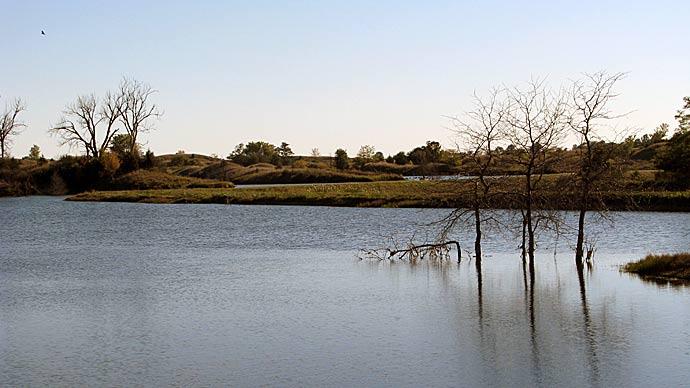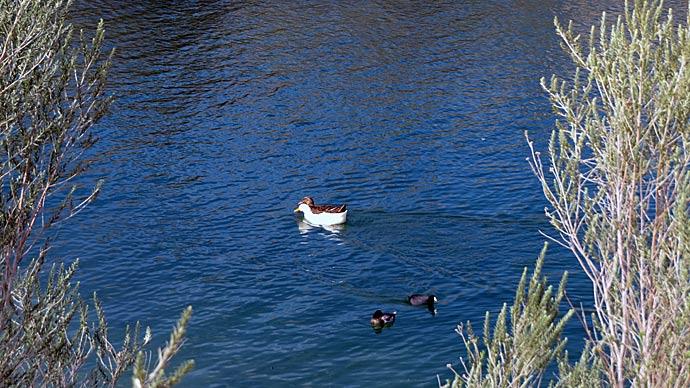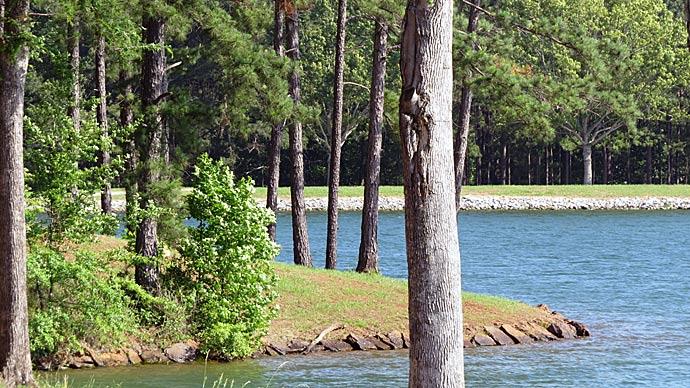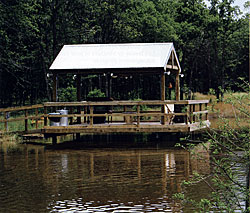
Want to build a pond, do you? Why? How big do you want it? How big can you make it? What kind of information should you have before you start? Where can you get information on the right way to build a pond the first time? Geez, so many decisions, so little time.
First and foremost ... make a plan. The more you know in advance, the smoother your project will go. It is incumbent on you to know as much as possible BEFORE the bulldozers show up.
Hear this ... lots of planning costs very little compared to the cost of fixing mistakes. Changes made during the pen and paper stages are much less painful than changes made when dirt begins to roll.
Accept Mother Nature's offerings. Accept your budget. If those two can't be married, put off the project until they can grow together... and that means your budget needs to grow, first. If Mother Nature dictates a large pond on your watershed, don't build a small one. Mother Nature will win. She always does.
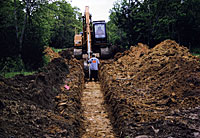
When things become complicated during your planning phase, or even when the earthmovers are doing what they do, remember the two basic necessities... dirt and water. That's your fundamentals. This process becomes much simpler if you have "good" dirt and plentiful water. Not excessive water, but plentiful. Think about that concept. It's important.
I looked at a beautiful pond at the northern edge of the Texas Hill Country not long ago. Beautiful setting amongst big live oak trees, nestled in a valley surrounded by rock outcroppings and tall, cedar covered hills. This pond covers about six acres.
It rained. Pond filled.
Pond drained. Empty.
Plentiful water, poor soils. No good... unless you want a part time pond and part time meadow.
If a pond fills up after a good rain, but the water does not stay, nothing has been accomplished.
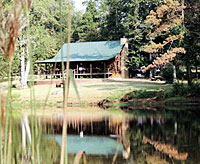
The same holds true with water, the best dam building material will not amount to anything if there is not enough water to fill up the pond. I've seen some giant earthen monuments to poor planning.
"Bad" dirt can be worked around, manipulated, and processed with good dirt, so long as it can be compacted. So can a shortage of rain water as long as you can figure out how to collect and keep what you get, but you need to know what you are up against before starting. This is a good time to check with a local engineer or dirt contractor to help advise you how to make the best decisions with marginal quality dirt or the "wrong" amount of water.
Here are a couple of things you can do to get the ball rolling.
Study the area where you want your pond, measure how much it rains and see how much water comes into the proposed site. A big rain and lots of running water is a good sign. The volume of water coming in will help you make an intelligent decision on the size of the pond. Topographical maps give you information to calculate how many acres drain into your site. Compare that watershed size to the volume of water coming down the creek. Once you understand how much water is coming, you can start thinking about how much effort needs to be put into managing and routing excess water.
The other necessary piece of the puzzle is the dirt. When thinking about soils, remember clay works best. Sand and gravel will not hold water. Sounds simple, but I cannot tell you how many times I see a leaky pond that has sand or gravel in it. Look around at ponds in the neighborhood. One of the best indicators for the kind of dirt we have is the surrounding area. Take a drive around and look at other ponds. How full are they? How long has it been since the last rain? Let's say it has not rained in three weeks and all the ponds you see are almost full, that is a good sign.
Get a shovel, dig a hole as deep as possible, fill it with water, and see how long it takes the water to disappear. After five minutes, repeat and allow the soil around the hole to soak up the water. Another way to test your soil is to grab a handful of the dirt, add water, and make a ball out of it if it. Does it stay together? If so, that is a good sign. Next put the ball back in the water and see if it will stay in one piece. Sometimes that ball will be in the same shape the next day. If it is, you are in good shape. Find clay. If clay is sparse or doesn't exist, learn your options to amend it ... before you bring in the heavy equipment.
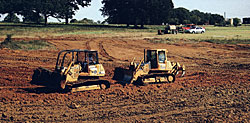
Let's get to more of the fun stuff. More planning. What do you want to end up with when this project is finished?
Are you planning to put a house on the property? Is it going to be a weekend retreat or a full time residence? How close to the water do you want the house? Do you have any trees that you really want to save that you might lose if you build a pond?
These are some of the things you want to start thinking about.
Next on the planning schedule is to determine the shoreline, where the water will be when the pond is full. This can take a couple of tries, so start as high as you can. Every pond has its limiting factor. Shooting the elevations and marking the shoreline helps define the first limiting factor.
Several things need to be considered. A pond has to be completely on your property. No part of the water or the dirt you move can encroach on neighboring property without their permission. If permission is needed, get it in writing. The same is true downstream of the dam. All water that travels across your property must enter the neighbor's in the same place as it did before the construction began. Water cannot be diverted into another creek.
The lay of the land will dictate where the shoreline will naturally lie. Here's where we often get into a bit of a tussle with Mother Nature. Some people want shoreline where it won't naturally flow. Any place you want water can be marked. But, it may not make sense to move water too far from the natural setting, but now is the time to check. This is a classic example to plan before your work.
As a professional earthmover, I understand as well as anyone that much of this information seems complicated. If it's complicated to you - the testing of soil, figuring out how much watershed you have, flagging the shoreline... don't be afraid to ask for outside help.
Ultimately, the shoreline will be determined by spillway elevation. The neighbor's fence, a road, or a grove of trees will all play a part in the final spillway location, once you see what will be flooded.
Before you get too much further, think about some other things. What kind of fish do you want? Plan for habitat for those fish. Are the kids and grandkids going to play in and around the water? Think about safety, a beach, a dock. Do you want the area around the pond to look like a state park? This means you will need a mower. The actual construction work will be a little different if you decide on a "natural" setting. Waterfowl and song birds, deer and turkey are just as important as fish ... in the planning stages.
Have you started to think about a budget?
How long do you plan to keep the land? Most people tell me they will not ever sell their place, but let me tell you, all land sells sooner or later, either by you or the next generation... unless you set up a conservation easement. The money you spend on a properly designed and built pond is never wasted. If you do your homework and follow a good plan, a pond will add value to the property and make it a lot easier to sell, if and when the time comes.
Think about where you want your road to be. Do you want to drive across the dam? If so, plan on a wider crown and a concrete spillway.
What about animals? Are you planning to have a few horses or some cattle? Or are you going to have a lot of livestock? A recreational pond can water the livestock without disrupting your fun, if you plan in advance.
The bottom line? Almost anything can be made to work, so long as you plan for it, budget for it and see it to completion. Spend time on the Pond Boss discussion forum, bring out company representatives who help plan and build lakes or ponds. Seek as much advice as you need to feel and think comfortably with your project... beforehand.
When the lake is built and you are on your dock watching the kids row around in a canoe, feet kicked up with your favorite beverage, you don't want to be thinking about why you didn't add a pipe to water the garden or why you left all that shallow water that has since filled with invasive amounts of some unknown underwater salad bar that you can't eat.
You really don't want to sit around fretting over what you could have, or should have, done.
You want to smile and laugh and enjoy your surroundings.
After all, that is the plan, isn't it?
Reprinted with permission from Pond Boss Magazine

